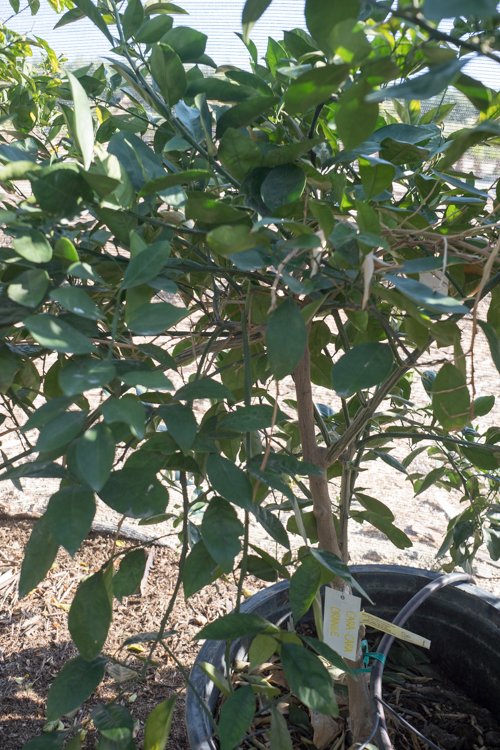Cara Cara Orange Tree
Cara Cara orange tree is one of the more unusual citrus trees we have to offer.
Although Cara Cara oranges look like navel orange trees, when you peel them open, you’ll see pink flesh, similar to grapefruits. When used in juices and desserts, Cara Cara oranges add lots of vibrant color as well as sweetness.
These oranges are not always available in most grocery stores, so why not grow your own to secure your supply?
Botanical name: Citrus sinensis 'Cara Cara'
Other names: Red navel orange tree
Large Cara Cara orange trees for sale at our nursery
TABLE OF CONTENTS
Cara Cara Orange tree Appearance
Cara Cara orange tree is a medium-sized evergreen tree that can reach 20 feet in height and 15 feet in width.
It has a rounded shape with dense, glossy deep green foliage. The leaves are oval and can grow to 4 inches long.
Small, white flowers with a strong, pleasant fragrance in the spring.
Followed by Cara Cara oranges, which look very similar to traditional navel oranges but have pink flesh. Bright orange and smooth skin. These fruits typically ripen in the fall or winter.
Cara Cara Orange tree Landscaping Tips
The fruit has very few seeds and a sweet, juicy flavor. This tree is thought to be from a navel orange tree, but the fruits are much sweeter.
Keep it in a container and overwinter indoors if your region experiences below-freezing temperatures.
This is a fast-growing tree. We recommend doing the heaviest pruning in the late winter to keep the size in check.
Cara Cara Orange tree Origin
Cara cara is believed to be a hybrid orange discovered in Venezuela
Cara Cara Orange tree Care
Soil: Fertile, well-draining soil that is slightly acidic to acidic. Use a fertilizer formulated for citrus trees.
Temperature: Can withstand temperatures down to 25 degrees for a short period of time. If you live in a climate that experiences cold winters, we recommend overwintering them indoors.
Water: Moderate water needs. Regular deep watering, especially when blooming and fruiting and during heat waves. Do not allow soil to dry out completely for an extended period of time. More drought-tolerant once mature.
Sun: Full sun
Cara Cara Orange tree Problems
Cara cara orange tree for sale
Pests: Cara Cara orange trees may attract pests such as aphids, mealybugs, and scale.
For aphids, blast them off with water if the infestation is light. Otherwise, use horticultural oil or soapy water.
To remove mealybugs, use insecticidal soap or apply rubbing alcohol directly to the area of the infestation using a cotton swab.
To remove scales, pick them off or use horticultural oil or insecticidal soap. Horticultural oil will kill both crawlers and adults with direct contact. Insecticidal soap is better used to target only the crawlers.
Whenever using any kind of pesticide, be aware that it can damage the plant if the temperatures are in the 80s or above.
Signs of overwatering: Root rot, drooping leaves
Signs of too little water: Browning and drying leaves
Signs of too much sun: Leaf burn, fading color
Signs of too little sun: Etiolation, stunted growth, few flowers
Cara Cara Orange tree Propagation
The easiest way to propagate a Cara Cara orange tree is through cuttings. Obtain 1-foot-long semi-hardwood cuttings with a sharp tool and plant them in the soil. Keep soil moist until it's well established.
FAQ
HOW MUCH DOES a Cara Cara Orange Tree COST?
At our nursery, Cara Cara orange trees cost $45 for 5-gallon, $150 for a 15-gallon container, and $325 for a 24” box.
Prices are subject to change. Please contact us for the most up-to-date pricing information. We may have larger sizes available. We provide installation services locally at a separate cost.
When does a Cara Cara orange tree produce fruit?
The Cara Cara orange tree typically produces fruit that ripens from fall through winter.
How long does it take for a cara cara orange tree to bear fruit?
Most orange trees start to bear fruit when they're about 3 years old.
Summary
| SIZE (H X W) | 20 feet X 15 feet |
|---|---|
| FLOWER COLOR | White |
| FLOWER SEASON | Spring |
| EXPOSURE | Full Sun |
| WATER | Moderate |
| GROWTH RATE | Fast |
| HARDINESS | 25º F, USDA Zone 9 |
| PRUNING | As needed |

